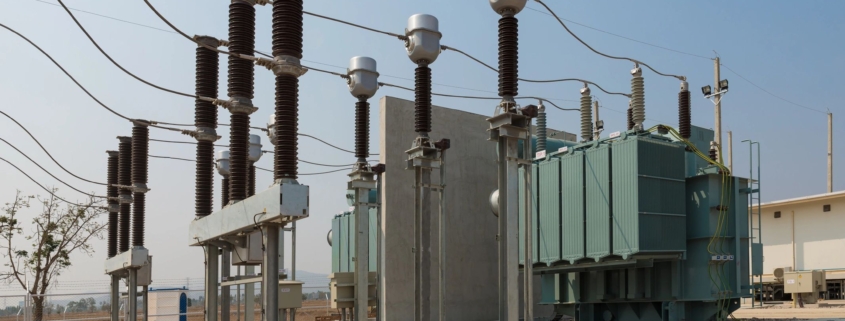
ELECTRICAL SUBSTATION
Definition – A substation is a part of electrical system which starts from electricity generation, transmission and distribution. Substations receive & distribute power, transform voltage from high to low, or low to high, or perform many other important functions.
Substations generally have circuit breakers, relays & transformers which are used to distribute power, detect & isolate faults like short-circuits, overload currents or earth fault that may occur on the network. Other devices may also be installed at substations like power factor correction capacitors and voltage regulators etc.
Electric power flows from generating plants to the consumers through various substations in between. During this journey of power, voltage level changes depending on the type of transmission & distribution systems. For example – suppose a generating plant generates power at 11KV or 16.5KV or 21KVor 33KV, the voltage is then stepped up for transmission of power. Transmission of power is done on high voltage because voltage is inversely proportional to the current so less current flows in the system. Voltage may be stepped up to 66Kv, 110Kv, 132Kv, 220KV, 400Kv & 765KV etc. Transmission of power is done between generating plant & the area (like city, industrial area etc) where power is required. Power is stepped down & is distributed in city /industrial area. Distribution of power is done at a voltage of either 33Kv or 11Kv.
The highest voltage at which AC power is transmitted in India is 765KV.
(Note- Voltage stepping up & down is done in sub-stations through transformers. We should remember that the power input & output remains same when voltage change takes place because the current value changes accordingly.)
A substation that has a step-up transformer increases the voltage but decreases the current similarly step-down transformer decreases the voltage& increases the current value.
Classification of Sub-Stations –
According to constructional feature, the substations are classified as –
Indoor Substation,
Outdoor Substation,
Underground Substation,
Pole mounted Substation,
Indoor Substation –
The substations which are installed inside a building is called indoor substation. These substations are installed up to 11Kv. However, when atmospheric conditions are not suitable i.e. contaminated with impurities, these substations can be installed upto 66KV.
Outdoor Substation –
For voltages beyond 66 KV, outdoor substations are preferable for such high voltages. It is because for high voltages, clearance between conductors & the space required for switches, circuit breakers, & other equipment becomes so great that it is not economical to install the equipment indoor.
Underground Substations –
Underground substations are created in highly orthickly populated area where space constraint is there.
Pole-mounted Substation–
This is an outdoor substation where equipment are installed overhead on H – pole or 4-pole structure. It is the cheapest form of substation for voltages up to 11Kv or 33 KV.Electric power is almost distributed in localities through such substations.
(Note – In this chapter we will focus on Indoor substation only.)
Indoor Substation –
In Commercial buildings, malls, residential multistory building, factory etc Following sequence is followed in substation to get power from Govt supply –
H – Pole –
Where HT power at 11KV or 33KV is received. An 11KV H-pole consists of Lightning Arrester (LA), Gang Operated (GO) switch, Dropout (DO) fuse, jumpers, supporting insulators & necessary accessories. Incoming supply comes from Overhead Lines passing in the area. If HT line is passing close to the building then it is taken through jumper. Or if line is away across the road then supply is taken through HT cable. Cable is laid under the road to connect both ends, one end is HT line & other end is H-pole. Outgoing cable from H-pole is laid to the HT Isolator or HT panel room of the building where power is required. Location of HT panel is inside the boundary of the building premises.
HT Panel –
An HT panel is ametal enclosure which is fitted with HT Breakers, Protection relays, meters to monitor different electrical parameters. Normally a HT panel has incoming & outgoing feeders. Incoming feeder receives HT supply from H-pole through HT cable. HT power is distributed from HT panel through its outgoing feeders. HT cables are laid from outgoing feeders to step down Transformers (33KV/0.415 KV, or 11KV/0.415KV).
HT panel is equipped with the protection relays for the transformer. If a fault occurs in the transformer then it is protected by relays installed in HT panel &breaker of faulty transform gets tripped & supply is disconnected.
Isolator – HT isolator is aswitching device enclosed in a metal enclosure which is installed at the boundary of the building near the H pole It has no protection facility. It is an off line device &is operated when there is no load in the system.
Transformer – It is a static device which transforms electrical energy from one circuit to another with the help of mutual induction between two windings with no direct electrical connection. It transforms power from one circuit (high voltage) to another (Low Voltage) without changing its frequency & vise- versa.
Outgoing voltage of step down transformer is LT voltage i.e 415 V. The outgoing of transformer is connected with in-comer of LT panel through LT cables or bus ducts.
LT Panel –
LT (Low Tension) panel is an enclosure which houses ACBs, MCCBs, MCBs, fault protection relays, metering devices etc. LT panel receives LT supply i.e 415V through incoming feeders from transformer. LT panel consists of incoming, outgoing & bus-coupler feeders. Incoming feeders receives supply from outgoing of transformer or through DG sets (which are installed for back up of power)& outgoing feeders distribute supply to various loads of the building. Bus-couplers are used to divide the panel into various sections.
Note – NBC 16 (National Building Code of India 16) provides complete details of electrical system which are required to follow when a building is constructed. Different sections cover different requirement of electrical system.
Electrical Substation’s related guidelines are given in the link below –
